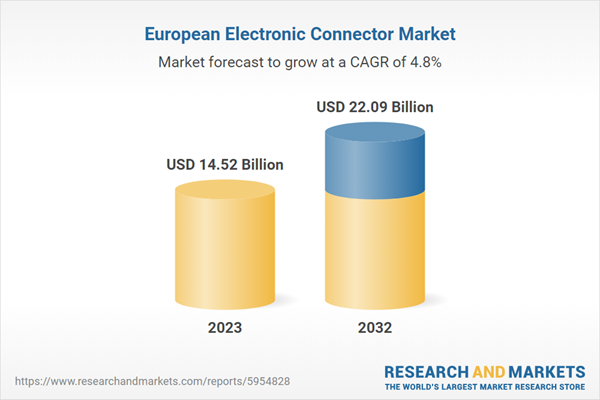This report comes with 10% free customization, enabling you to add data that meets your specific business needs.
The Europe electronic connector market (excluding U.K.) is projected to reach $22.09 billion by 2032 from $14.52 billion in 2023, growing at a CAGR of 4.78% during the forecast period 2023-2032. The expansion of the Europe electronic connector market is anticipated to be propelled by rising demand for sophisticated and effective electronic connectors across various applications, including automotive and transportation, computers and peripherals, and telecommunications.
Market Introduction
The electronic connection market in Europe is expanding rapidly, owing to a variety of causes. With rising demand for innovative and efficient electronic connections in a variety of industries, including automotive, transportation, computer, and telecommunications, the industry is seeing a spike in adoption. Electronic connectors are essential for ensuring seamless connectivity and data transmission in a variety of electronic devices and systems.
The automotive and transportation sector in Europe, which is characterized by the fast integration of sophisticated technologies such as electric vehicles (EVs), autonomous driving systems, and connected vehicles, contributes significantly to the demand for electronic connectors. These connectors are critical components in automotive electronics, including entertainment systems, sensors, and control units, which improve vehicle performance and usefulness.
Furthermore, the growth of smart devices, IoT (Internet of Things) applications, and data centers is increasing the demand for electronic connections in the computing and telecommunications industries. These connections provide dependable connectivity and efficient data transfer in a wide range of devices, including smartphones, tablets, servers, and networking equipment.
Furthermore, technical improvements such as electronic component shrinking, faster data transfer speeds, and better durability are influencing the evolution of Europe's electronic connection industry. Government actions to promote digitalization, as well as investments in infrastructure development, help to drive market growth.
Overall, the European electronic connector market offers considerable potential for manufacturers and suppliers to capitalize on the region's growing need for high-quality, dependable electronic connecting solutions across a variety of industries.
Market Segmentation:
Segmentation 1: by Application
- Computers and Peripherals
- Consumer Electronics
- Automotive and Transportation
- Telecom
- Energy and Power
- Others (Industrial, Military, and Medical, among others)
Segmentation 2: by Product Type
- I/O Connectors
- Printed Circuit Board (PCB) Connectors
- RF Coaxial Connectors
- Fiber Optic Connectors
- Others (Circular Connectors, Rectangular Connectors, and others)
Segmentation 3: by Country
- Germany
- France
- Italy
- Rest-of-Europe
How can this report add value to an organization?
Product/Innovation Strategy: The product segment helps the reader understand the different types of electronic connector products available by product type (I/O connectors, printed circuit board (PCB) connectors, RF coaxial connectors, fiber optic connectors, and others (circular connectors, rectangular connectors, and others)), by application (computers and peripherals, consumer electronics, automotive and transportation, telecom, energy and power, others (industrial, military, and medical, among others)). Increasing automotive and transportation demand worldwide is pushing the sales of electronic connector systems. Therefore, the electronic connector business is a high-investment and high-revenue generating model.
Growth/Marketing Strategy: The Europe electronic connector market is exponentially growing, with enormous opportunities for the market players. Some strategies covered in this segment are product launches, partnerships and collaborations, business expansions, and investments. The companies' preferred strategies have been product launches, partnerships, and collaborations to strengthen their positions in the Europe electronic connector market.
Competitive Strategy: Key players in the Europe electronic connector market analyzed and profiled in the study involve electronic connector-based product manufacturers and start-ups. Moreover, a detailed competitive benchmarking of the players operating in the Europe electronic connector market has been done to help the reader understand how players stack against each other, presenting a clear market landscape. Additionally, comprehensive competitive strategies such as partnerships, agreements, and collaborations will aid the reader in understanding the untapped revenue pockets in the market.
Key Market Players and Competition Synopsis
The companies that are profiled have been selected based on inputs gathered from primary experts and analyzing company coverage, type portfolio, and market penetration.
Some prominent names in the market include:
- Aptiv PLC
- Phoenix Contact
- Rosenberger Group
- HARTING Technology Group
This product will be delivered within 3-5 business days.
Table of Contents
Companies Mentioned
- TE Connectivity
- Aptiv PLC
- Rosenberger Group
- HARTING Technology Group
- Phoenix Contact
- HUBER+SUHNER
- Radiall
- LEMO Group
- Weidmüller Interface GmbH & Co. KG
- WAGO
Table Information
| Report Attribute | Details |
|---|---|
| No. of Pages | 116 |
| Published | April 2024 |
| Forecast Period | 2023 - 2032 |
| Estimated Market Value ( USD | $ 14.52 Billion |
| Forecasted Market Value ( USD | $ 22.09 Billion |
| Compound Annual Growth Rate | 4.7% |
| Regions Covered | Europe |
| No. of Companies Mentioned | 10 |









